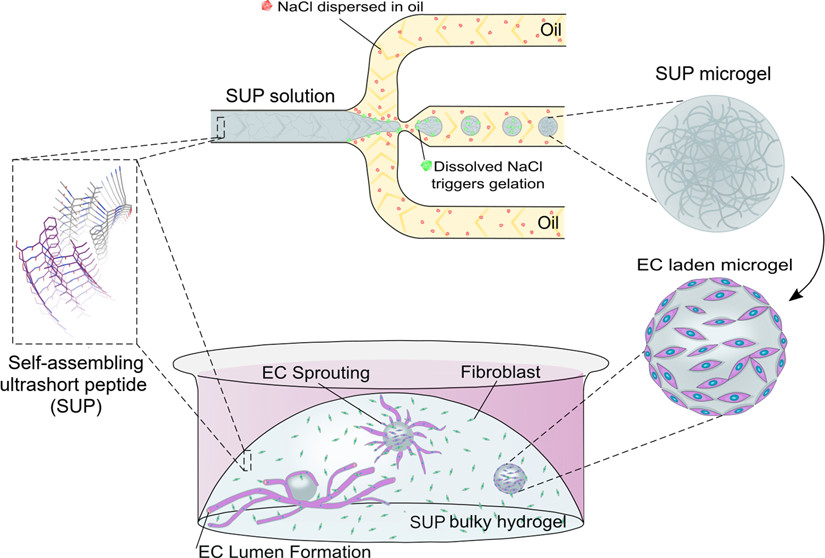
Blood vessel generation is an essential process for tissue formation, regeneration, and repair. Notwithstanding, vascularized tissue fabrication in vitro remains a challenge, as current fabrication techniques and biomaterials lack translational potential in medicine. Naturally derived biomaterials harbor the risk of immunogenicity and pathogen transmission, while synthetic materials need functionalization or blending to improve their biocompatibility. In addition, the traditional top-down fabrication techniques do not recreate the native tissue microarchitecture. Self-assembling ultrashort peptides (SUPs) are promising chemically synthesized natural materials that self-assemble into three-dimensional nanofibrous hydrogels resembling the extracellular matrix (ECM). Here, we use a modular tissue-engineering approach, embedding SUP microgels loaded with human umbilical vein endothelial cells (HUVECs) into a 3D SUP hydrogel containing human dermal fibroblast neonatal (HDFn) cells to trigger angiogenesis. The SUPs IVFK and IVZK were used to fabricate microgels that gel in a water-in-oil emulsion using a microfluidic droplet generator chip. The fabricated SUP microgels are round structures that are 300–350 μm diameter in size and have ECM-like topography. In addition, they are stable enough to keep their original size and shape under cell culture conditions and long-term storage. When the SUP microgels were used as microcarriers for growing HUVECs and HDFn cells on the microgel surface, cell attachment, stretching, and proliferation could be demonstrated. Finally, we performed an angiogenesis assay in both SUP hydrogels using all SUP combinations between micro- and bulky hydrogels. Endothelial cells were able to migrate from the microgel to the surrounding area, showing angiogenesis features such as sprouting, branching, coalescence, and lumen formation. Although both SUP hydrogels support vascular network formation, IVFK outperformed IVZK in terms of vessel network extension and branching. Overall, these results demonstrated that cell-laden SUP microgels have great potential to be used as a microcarrier cell delivery system, encouraging us to study the angiogenesis process and to develop vascularized tissue-engineering therapies.


"KAUST shall be a beacon for peace, hope and reconciliation, and shall serve the people of the Kingdom and the world."
King Abdullah bin Abdulaziz Al Saud, 1924 – 2015
Thuwal 23955-6900, Kingdom of Saudi Arabia
Al-Haytham Building (Bldg. 2)
© King Abdullah University of Science and Technology. All rights reserved